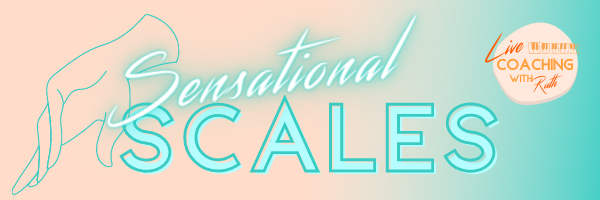Just the word 'scales' conjures up memories of dry, boring, regimented exercises…
But on this journey toward becoming a creative pianist, you might have imagined we'd be leaving scales in the dust, right?
In this article you'll discover how creative pianists can use scales to their advantage!
Watch the video below or read on for the abridged text version.
What are the benefits of learning & practising scales?
1. learning scales is learning keys!
The more keys you know well, the easier it will be for you to play songs in different keys, to transpose when needed, to improvise in different keys, play a key change for that final chorus of the song… there’s loads of situations where knowing your scales/key signatures will serve you well.
2. scales provide a foundation for creative play!
You can use a full or partial scale for improvisation, composing, and quick runs in between chord progressions. Learning how to play them well, with proper fingering & technique means you can play them effortlessly whenever you need to.
3. scales exercise the fingers!
Scales remain one of the most effective (and easiest to remember) ways to warm up our fingers for playing songs. They help us to master fingering techniques in order to play them smoothly and quickly. When you focus on finger, hand & wrist movements required to play a scale well, you will reap those benefits while you are playing your pieces too. You’ll begin to gain better dexterity and agility in your fingers and protect yourself from injury due to poor technique.
5 ways to take the stale out of scales:
1. Double up the practise value: Add dynamics!
Gradually change from loud to soft as you play the scale, or play a different dynamic in each hand - this develops your control over the dynamics and expression – as well as memorising your scales/keys.
2. Double up the practise value: Add articulation!
Cycle through different articulation techniques: legato (smooth & joined) to staccato (short & detached) and back again. Try marcato (forced staccato) and accenting too. This builds your articulation technique.
3. Make it fun with rhythm: Swing!
Try using a dotted crotchet + quaver rhythm (long-short-long-short) as a way to practise rhythms with your scales. Or try a true swing beat (look up a basic swing drum beat on the internet to get the feel right).
4. Make it fun with rhythm: Half-time!
Start by playing one note on each beat of a 4/4 time signature. Then try playing it halving the note values (to 1 + 2 + 3 + 4 + etc). Then halve the note values again… and again… by doing this you are playing with acceleration and deceleration (shorter and longer duration of notes).
5. Make it fun with rhythm: Tempo changes!
Try playing the scale slow at first and gradually speed it up as you go through the scale ascending and descending. This change in tempo is difficult to make consistent - so it’s a really great technique to work on over time. You can try the other way too, start faster and gradually slow down - again the trick is to get the slowing of the tempo consistent. Give it a go! This works on your ritardando (getting slower) and accelerando (getting faster).
Want to learn more?
‘Sensational Scales’ will teach you how to play scales with correct fingering, how to memorise the notes of each scale and creative kickstarters to use at home using scales!


![Am I too old to start playing piano? [Student story]](https://images.squarespace-cdn.com/content/v1/598feec015d5db6d7e409176/1647402950192-R49L48S0PZILF5V9WO1M/_FB+LIVE+_thumb_impossible.png)


















